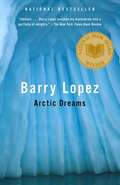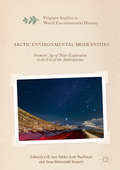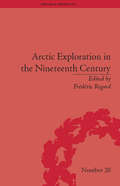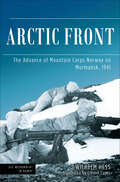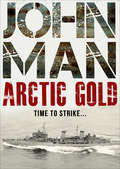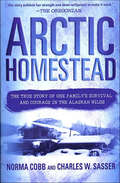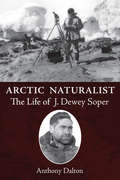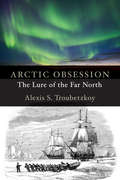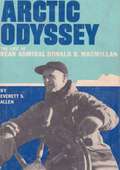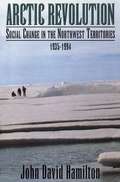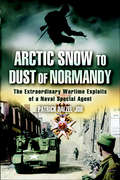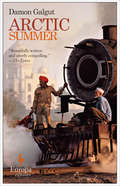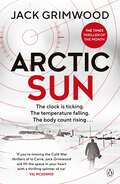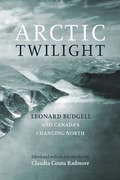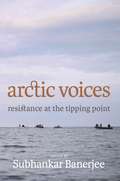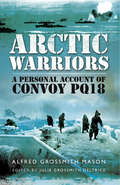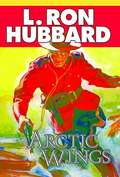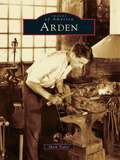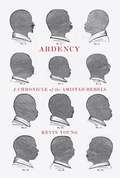- Table View
- List View
Arctic Dreams: Imagination and Desire in a Northern Landscape
by Barry Holstun LopezThis National Book Award winner examines the Far North - its terrain, wildlife, and history of the Eskimo natives and intrepid explorers who arrived on its icy shores. What turns this compendium of biology, anthropology and history into a breathtaking study of profound originality is Lopez's unique meditation on how the landscape can shape our imagination, desires and dreams.
Arctic Environmental Modernities: From the Age of Polar Exploration to the Era of the Anthropocene (Palgrave Studies in World Environmental History)
by Lill-Ann Körber Anna Westerståhl Stenport Scott MacKenzieThis book offers a diverse and groundbreaking account of the intersections between modernities and environments in the circumpolar global North, foregrounding the Arctic as a critical space of modernity, where the past, present, and future of the planet’s environmental and political systems are projected and imagined. Investigating the Arctic region as a privileged site of modernity, this book articulates the globally significant, but often overlooked, junctures between environmentalism and sustainability, indigenous epistemologies and scientific rhetoric, and decolonization strategies and governmentality. With international expertise made easily accessible, readers can observe and understand the rise and conflicted status of Arctic modernities, from the nineteenth century polar explorer era to the present day of anthropogenic climate change.
Arctic Exploration in the Nineteenth Century: Discovering the Northwest Passage (Empires in Perspective)
by Frédéric RegardFocusing on nineteenth-century attempts to locate the northwest passage, the essays in this volume present this quest as a central element of British culture.
Arctic Front: Defending Canada in the Far North
by P. Whitney Lackenbauer Ken S. Coates William R. Morrion Greg PoelzerA hard-hitting, timely, and provocative book about the history and future of the Canadian Arctic. With passion and sharp words, Arctic Front confronts Canada’s longstanding neglect of the Far North and outline what needs to be done to protect our national interest. Through a lively and engaging history of the region, Arctic Front reveals how Canadians and their governments have:ignored this region for generationsexpanded Canadian sovereignty over the past hundred years by reacting to other countries’ challengesbecome the least effective of all Circumpolar nations in responding to the needs of the Arcticneglected our obligations to the North, including a failure to capitalize on the human and economic resources of this vast land or to establish a presence that would make any foreign claims to offshore resources inconceivable.As global warming continues to melt the ice in the Northwest Passage and the competition for northern resources heats up, Canada, the authors warn, will be forced to defend this area from a position of grave weakness. Our leaders need to take action today, blending defence and development, to complete Canadian nation building in this fragile region. An energetic and engaging collaboration by four of Canada’s leading Northern specialists, Arctic Front is a clarion call to all Canadians about our endangered Arctic region, challenging the country to step away from the symbols and myth making of the past and toward the urgent political, environmental and economic realities of the 21st century.
Arctic Front: The Advance of Mountain Corps Norway on Murmansk, 1941 (Die Wehrmacht im Kampf)
by Wilhelm Hess“A very thorough analysis as to why and how the combined German-Finnish army . . . ultimately failed in their quest to seize Murmansk during Barbarossa.” —Globe at WarIn 1941, military operations were conducted by large formations along the northern coast of Scandinavia—for the first time in the history of warfare. The Arctic Front was the northernmost theater in the war waged by Germany against Russia. For a period of four years, German troops from all branches of the Wehrmacht fought side by side with Finnish border guard units.The high point of the war on the Arctic Front was the assembly and advance of Germany’s Mountain Corps Norway in the summer and autumn of 1941. Commanded by general of the mountain troops, Eduard Dietl, and composed of the 2nd and 3rd Mountain Divisions, the Mountain Corps advanced out of occupied North Norway, assembled in the Petsamo Corridor in North Finland, and struck into Russian territory in an attempt to seize Murmansk. It did not reach its objective. This account of the operation was written by Wilhelm Hess, quartermaster of the Mountain Corps Norway. He draws upon his personal experience of the conditions and actions on the Arctic Front in order to describe and analyze the environment, the sequence of events, and the reasons behind certain decisions. In addition to describing how operations conducted by the Mountain Corps unfolded, Hess provides insight as to how the terrain, the flow of supplies, and the war at sea impacted those operations.“A serious, thoughtful book about war . . . in conditions hardly conducive to survival, let alone combat.” —Stone & Stone
Arctic Gold
by John ManA man searches for the sunken treasure he once protected as a sailor in WWII in this “thrilling action story” from the acclaimed historian (Tom Kasey, author of Trade Off). Murmansk, Russia, 1942. The HMS Edinburgh is sailing deep in Russian territory, a bulwark against Nazi invaders. Among the eight-hundred-strong crew is Mike Cox, a sixteen-year-old boy from the East End, London who is about to be thrown into the heat of war. A Russian ship approaches the Edinburgh with a very precious cargo—over a thousand tons of gold—as payment from the Soviet Union for the Royal Navy’s protection. Now the English ship is tasked with safeguarding a fortune as well as the Barents Sea. But when a German U-boat fires torpedoes at the Edinburgh’s hull, the crew must fight for their lives . . . and Mike is one of only a few survivors to escape from the wreck as the gold sinks eight hundred feet to the bottom of the sea. After making his way back to London, Mike finds himself more alone than ever. He starts training to become a diver with one objective in mind: to rescue that precious Arctic gold. But he’ll have to act quick—he’s not the only one looking for it . . .
Arctic Homestead: The True Story of One Family's Survival and Courage in the Alaskan Wilds
by Charles W. Sasser Norma Cobb“A memoir as wild, engaging, stubborn, and authentic as that distant valley where [Cobb’s] family staked out the last plot in America.” —John Balzar, author of Yukon AloneIn 1973, Norma Cobb, her husband Lester and their five children—the oldest of whom was nine years old and the youngest, twins, barely one—pulled up stakes in the lower 48 and headed north to Alaska to follow a pioneer dream of claiming land under the Homestead Act. The only land available lay north of Fairbanks near the Arctic Circle where grizzlies outnumbered humans twenty to one. In addition to fierce winters and predatory animals, the Alaskan frontier drew the more unsavory elements of society’s fringes. From the beginning, the Cobbs found themselves pitted in a life or death feud with unscrupulous neighbors who would rob from new settlers, attempt to burn them out, shoot them and jump their claim.The Cobbs were chechakos, tenderfeet, in a lost land that consumed even toughened settlers. Everything, including their “civilized” past, conspired to defeat them. They constructed a cabin—and first snow collapsed the roof. They built too near the creek and spring breakup threatened to flood them out. Bears prowled the nearby woods, stalking the children and Lester Cobb would leave for months at a time in search of work.But through it all, they survived on the strength of Norma Cobb—a woman whose love for her family knew no bounds and whose courage in the face of mortal danger is an inspiration to us all. Arctic Homestead is her story.“Her story exhibits her strength and sheer willpower to make it work.” —Oregonian
Arctic Landscapes and Traditions 3-Book Bundle: Ukkusiksalik / Uvajuq / Thelon
by David F. PellyFrom an explorer of the North's cultural landscape, comes the stories and history of remote corners of our North. David F. Pelly gives a rare in-depth account of Inuit history based on oral testimony and historical records. Includes: Ukkusiksalik: The People's Story Ukkusiksalik, now a national park, was in earlier times the principal hunting ground for several Inuit families and was criss-crossed by missionaries, Mounties, and traders. David F. Pelly presents the stories of Inuit elders and historical records to provide a complete history of this extraordinary corner of our northern landscape. Uvajuq: The Origin of Death The Inuit story of Uvajuq (oo-va-yook) is rooted in a time when people and animals lived in such harmony and unity that they could speak to each other. The legend of Uvajuq, as told here, was collected from a group of Inuit elders in the Nunavut community of Cambridge Bay, 300 kilometres north of the Arctic Circle. Thelon: A River Sanctuary David Pelly tells the story of the Thelon, exploring the mystery of humankind's relationship with this special place in the heart of Canada's vast Arctic Barren Lands.
Arctic Mirrors: Russia and the Small Peoples of the North
by Yuri SlezkineFor over five hundred years the Russians wondered what kind of people their Arctic and sub-Arctic subjects were. "They have mouths between their shoulders and eyes in their chests," reported a fifteenth-century tale. "They rove around, live of their own free will, and beat the Russian people," complained a seventeenth-century Cossack. "Their actions are exceedingly rude. They do not take off their hats and do not bow to each other," huffed an eighteenth-century scholar. They are "children of nature" and "guardians of ecological balance," rhapsodized early nineteenth-century and late twentieth-century romantics. Even the Bolsheviks, who categorized the circumpolar foragers as "authentic proletarians," were repeatedly puzzled by the "peoples from the late Neolithic period who, by virtue of their extreme backwardness, cannot keep up either economically or culturally with the furious speed of the emerging socialist society." Whether described as brutes, aliens, or endangered indigenous populations, the so-called small peoples of the north have consistently remained a point of contrast for speculations on Russian identity and a convenient testing ground for policies and images that grew out of these speculations. In Arctic Mirrors, a vividly rendered history of circumpolar peoples in the Russian empire and the Russian mind, Yuri Slezkine offers the first in-depth interpretation of this relationship. No other book in any language links the history of a colonized non-Russian people to the full sweep of Russian intellectual and cultural history. Enhancing his account with vintage prints and photographs, Slezkine reenacts the procession of Russian fur traders, missionaries, tsarist bureaucrats, radical intellectuals, professional ethnographers, and commissars who struggled to reform and conceptualize this most "alien" of their subject populations. Slezkine reconstructs from a vast range of sources the successive official policies and prevailing attitudes toward the northern peoples, interweaving the resonant narratives of Russian and indigenous contemporaries with the extravagant images of popular Russian fiction. As he examines the many ironies and ambivalences involved in successive Russian attempts to overcome northern--and hence their own--otherness, Slezkine explores the wider issues of ethnic identity, cultural change, nationalist rhetoric, and not-so European colonialism.
Arctic Naturalist: The Life of J. Dewey Soper
by Anthony DaltonDewey Soper first travelled to the Arctic in 1923. During the next seven years he accepted three research postings on Baffin Island, each of which lasted between one and two years. In 1929 he discovered the breeding grounds of the blue goose in the southwest corner of Baffin Island. He also charted the final unknown region of Baffin Island’s coastline. Later in life he worked in the western Arctic. Outside the Far North, Soper studied bison in Wood Buffalo National Park, documented bird life on the Prairies, and made a detailed study of small mammals in Alberta. Soper was the last of the great pioneer naturalists in Canada. He was also a skilled and meticulous explorer. As a naturalist, he was a major contributor to the National Museum of Canada, as well as to the University of Alberta and other museums across the country.
Arctic Obsession: The Lure of the Far North
by Alexis S. TroubetzkoyMore than an account of the human delusion and fortitude in penetrating one of the most inhospitable areas of the world, Arctic Obsession goes beyond the gripping history of northern exploration, of the searches for the Northwest and Northeast Passages.From early medieval times to the twenty-first century, what has been the beguiling attraction of the North? What manner of men were they who boldly ventured into those hostile and unpredictable regions, scores never to return home, swallowed up by the merciless north.Today’s Arctic is developing into tomorrows hot spot. Arctic Obsession dwells on contemporary issues besetting the most fragile part of our globe global warming and environmental, ecological and geo-political concerns. The book also provides an overview of the entire Arctic region, from Canada, Russia, and Alaska to Greenland, Iceland, and the North Sea.
Arctic Obsession: The Lure of the Far North
by Alexis S. TroubetzkoyThe epic history of the explorers and adventurers who risked -- and sometimes lost -- their lives in the quest to conquer and claim the Arctic.Ever since approximately 325 BC, the Arctic has been the backdrop for tales of triumph and disaster, of hardship and horrors endured by those who were drawn to the northern latitudes. For centuries the major world powers sponsored teams of explorers seeking trade routes as well as the chance to claim new territories. These commercial interests brought them into contact with natives, who at first saw white crews die in the forbidding landscape they called home only to later succumb to disease, alcohol, and the drastic environmental changes wrought by global trade.At a time when global warming is drastically altering the region, Arctic Obsession chronicles an age when the Arctic remained one of the last unconquered places on Earth.
Arctic Odyssey: The Life of Rear Admiral Donald B. MacMillan
by Everett S. AllenIN THESE PAGES, the reader will meet one of America’s foremost seafaring men and explorers. Donald B. MacMillan (1874-1970) was born in Provincetown on Cape Cod and orphaned at an early age. After working his way through Bowdoin College and a brief stint at teaching, he became one of Robert E. Peary’s chief assistants on the arctic expedition that finally fought its way across the bitter Polar Sea to reach the North Pole.There followed a series of arctic expeditions spanning nearly half a century to Labrador, Baffin Island, to King Christian Island, Ellesmere Island and other unknown areas of the Arctic, resulting in valuable work in botany, ornithology, meteorology, and anthropology. He proved that Crocker Land did not exist.The story of the schooner Bowdoin, which for many years visited the North with a crew of scientists and amateurs, is told in detail, as well as the researchers and friendships developed with the Eskimos, in which Miriam MacMillan played a significant part.Arctic Odyssey is the thrilling story of a rich and exciting way of life, centering in the lusty and vigorous personality of one of the last and most colorful representatives of the heroic era of arctic exploration.Everett S. Allen (1916-1990) was an experienced newspaper reporter for The Standard-Times in New Bedford, Massachusetts. For many years he followed the career of Rear Admiral MacMillan and worked closely with him while writing this book.
Arctic Revolution: Social Change in the Northwest Territories, 1935-1994
by John David HamiltonThis pathbreaking book offers some nononsense truths about northern development.
Arctic Snow to Dust of Normandy: The Extraordinary Wartime Exploits of a Naval Special Agent
by Patrick Dalzel-JobVery few men have a more exciting and dramatic story of their wartime activities to tell than Patrick Dalzel-Job. In 1940 using his special knowledge of North Norway's coast line he landed and moved over 10,000 Allied soldiers in local boats without the loss of a single life. Acting against specific orders he evacuated civilians from Narvik just before it was bombed—only the King of Norway's intervention halted his court martial. Thereafter his many adventures included spying on enemy shipping and operating behind the lines in France and Germany with Ian Fleming's special force unit '30AU'.
Arctic Summer
by Damon GalgutThis &“beautifully written and utterly compelling&” novel by the acclaimed South African author traces E. M. Forester&’s journey of self-discovery (The Times, London). The year is 1912, and the SS Birmingham is approaching India. On board is Edward Morgan Forster, a reserved man taunted by writer&’s block, attempting to come to terms with his art and his homosexuality. During his travels, the novelist confronts his fraught childhood and falls in unrequited love with his closest friend. He also finds himself surprisingly freed to explore his &“minorite&” desires as secretary to a most unusual Maharajah. Slowly, the strands of a story begin to gather in Forster&’s mind: a sense of impending menace, lust in close confines, under a hot, empty sky. But it will be another twelve years and a second stay in India before the publication of his finest work, A Passage to India. Shifting across the landscapes of India, Egypt, and England, Forster&’s life is informed by his relationships—from the Egyptian tram conductor Mohammed el-Adl, to the Greek poet and literary titan C. P. Cavafy. Damon Galgut&’s reimagining of Forster&’s life is a clear and sympathetic psychological probing of one of Britain&’s finest novelists. &“Galgut inhabits [Forster] with such sympathetic completeness, and in prose of such modest excellence that he starts to breathe on the page.&” —Financial Times
Arctic Sun: The intense and atmospheric Cold War thriller from award-winning author of Moskva and Nightfall Berlin (Tom Fox Trilogy Book 3) (Tom Fox Trilogy #3)
by Jack GrimwoodTHE TIMES THRILLER OF THE MONTH‘Strange alliances, personal vendettas and Cold War conspiracies build to a bloody climax in the snow’ - The Times Thriller of the Month‘This is a proper page-turning high-stakes thriller’ Crime TimeFrom the award-winning author of Moskva and Nightfall Berlin, a gripping suspense-filled thriller in the frozen North . . .Kola Peninsula, 1987. High in the Soviet Arctic, a tiny village houses an apocalyptic secret . . .When research zoologist Dr Amelia Blackburn ventures north to investigate the ravages of the Chernobyl reactor meltdown, she stumbles on the evidence of another sinister disaster on the Norway-Russia border - one that appears far from innocent. Mother Russia will stop at nothing to prevent this information from being revealed, putting Amelia and her team in grave danger from the moment they leave the site.When the news reaches London, the eyes of British intelligence turn to the one man with the knowledge and skills to bring her back to safety - and find out what has really happened in the frozen North.Major Tom Fox thought he'd put his intelligence career behind him, but wrapped in a custody battle for his young son, Charlie, a request from his high-ranking father-in-law forces his hand. When the reluctant spy reaches Russia, it quickly becomes clear that this is no ordinary mission.As Fox and Amelia fight for their lives - and their country - in Russia, Charlie is lead into dangers of his own in England. Three lives are about to be embroiled in the darkest secrets of the Cold War conflict - and a plot that, if left unchecked, will echo through history . . .Praise for Jack Grimwood'If you're missing the Cold War thrillers of le Carré, Jack Grimwood will fill the space in your heart with a thrilling splinter of ice' Val McDermid'Cold War thrillers - so atmospheric, SO SO GOOD, I recommend EXTREMELY highly' - Marian Keyes'The new le Carré . . . an absolutely brilliant page-turner . . . if you love thrillers, Jack Grimwood is a name you need to remember' BBC Radio 2 The Sara Cox Show'For those who enjoy vintage le Carré' Ian Rankin'Mesmerising . . . something special in the arena of international thrillers' Financial Times'Your new favourite thriller writer' Independent'Top-notch ... the suspense never wavers' Crimetime'The rejuvenation of the espionage thriller continues apace' Guardian
Arctic Twilight: Leonard Budgell and Canada's Changing North
by Claudia Coutu Radmore Leonard BudgellLeonard Budgell saw the Canadian North like nobody else. He put his observations into words as few others ever could.As a "Servant of the Bay" Budgell ran Hudson’s Bay Company trading posts for decades in isolated communities up the Labrador coast and across the Arctic. Living among aboriginal Canadians he witnessed episodes and heard stories that would never again be repeated - except he wrote them down. His pen memorably portrays everything from dancing northern lights and hunting practices of birds to astonishing human adventures and predicaments.Northern ways intact for centuries changed with rifles and motorboats, radios and electric generators, new foods and different medicines. Most often, it was Budgell who bridged the aboriginal and southern cultures, building and operating remote radio stations at places like Hebron, taking an RCMP officer into a settlement where a choice had to be made between two different codes of law and behaviour in a murder case. In Arctic Twilight, Budgell chronicles, in an outpouring of letters to a much younger female friend, a traditional way of life that was changing forever.Claudia Coutu Radmore, a teacher, writer, and artist, first met Len Budgell in Winnipeg when she was a fine arts student and he had retired from the Company. Their friendship grew stronger when he began writing remarkable letters after she returned to Queen’s University. Now edited and organized by her, this unique memoir is available to the public for the first time.
Arctic Voices: Resistance at the Tipping Point
by Subhankar BanerjeeA pristine environment of ecological richness and biodiversity. Home to generations of indigenous people for thousands of years. The location of vast quantities of oil, natural gas and coal. Largely uninhabited and long at the margins of global affairs, in the last decade Arctic Alaska has quickly become the most contested land in recent US history. World-renowned photographer, writer, and activist Subhankar Banerjee brings together first-person narratives from more than thirty prominent activists, writers, and researchers who address issues of climate change, resource war, and human rights with stunning urgency and groundbreaking research. From Gwich'in activist Sarah James's impassioned appeal, "We Are the Ones Who Have Everything to Lose," during the UN Climate Conference in Copenhagen in 2009 to an original piece by acclaimed historian Dan O'Neill about his recent trips to the Yukon Flats fish camps, Arctic Voices is a window into a remarkable region.Other contributors include Seth Kantner, Velma Wallis, Nick Jans, Debbie Miller, Andri Snaer Magnason, George Schaller, George Archibald, Cindy Shogan, and Peter Matthiessen.
Arctic Warriors: A Personal Account of Convoy PQ18
by Deltrice Alfred Grossmith Julie Grossmith DeltriceIn mid-1942 Alfred Grossmith Mason became Navigation/Gunnery Officer on SS Empire Baffin, a 6,978 ton cargo ship assigned to carry essential war supplies to the hard pressed Soviet Union. Fortunately he compiled this remarkable diary of the dramas and disasters that befell the ill-fated Convoy PQ18. This inspiring story follows the movement of his ship and the other merchantmen together with their Royal Naval escorts from the mustering point at Loch Ewe to their destination Archangel.Daily German attacks from the air and sea and long periods at action stations deprived crews of sleep. The loss of many ships and comrades and the ever-present prospect of death through drowning and hypothermia took their toll. Having to function while exhausted, ill-nourished and freezing cold demanded that every man gave of his utmost over a prolonged period. Yet remarkably, as this book shows, humour remained intact.Once in Archangel his insight into the hardships faced by the Russian population is revealing. For the surviving sailors there remained the awesome challenge of the return journey without any escort. Unlike so many, the Author finally reached Britain in December 1942.Arctic Warriors is a rare and graphic personal account that captures the atmosphere of this infamously costly convoy and others like it. If any doubts remain of the terrible conditions and dangers that merchant seamen aced in the hostile waters of the North Atlantic and Barents Sea, this superb record, published in the Year of the Convoy, will surely put them to rest.
Arctic Wings
by L. Ron HubbardSpring has come to White Bear Landing--and so has the law, in the firm hands of Royal Mounted policeman and pilot Bob Dixon. Dixon's as gruff, tough and good-looking as Russell Crowe, and in this outpost halfway between the arctic mines and civilization, he's known for taking the law to extremes.More than once Dixon has meted out his own brand of rough justice with hard fists and hot lead, but now the tables have turned. The past has come back to haunt him, he's been set up as a murder suspect, and a rogue's gallery of enemies are lining up to settle old scores . . .Out on the icy tundra, on the edge of the world, revenge can be cold--and brutal. Dixon's only hope is to let the trust of a good friend and the love of a good woman lead the way to true justice and redemption--on Arctic Wings.Hubbard never wrote a word, conceived a character, or described a setting without first finding out all he could about the people and places that drove his stories. He wrote: "I began to search for research on the theory that if I could get a glimmering of anything lying beyond a certain horizon, I could go deep enough to find an excellent story. I read exhaustively. I wanted information and nothing else." His exhaustive research--and search for the excellent story--comes through brilliantly in Arctic Wings.
Arcticologies: Early Modern Actions for Our Warmer World
by Lowell DuckertExploring the frozen past to rethink our warming future Do we really know what cold is? In Arcticologies, Lowell Duckert delves into early modern European texts to trace how representations of frigidity from the sixteenth and seventeenth centuries have contributed to historical understandings of climate and contemporary debates on climate change. Arguing that human culture and science are, in fact, indebted to the cold, Duckert suggests that these early depictions offer critical terms for advancing the aims of climate-change activism and assisting in counterapocalyptic thinking. An imaginative and intellectual journey, Arcticologies reveals the enduring role of cold in wide-ranging storytelling traditions. It draws on Shakespeare&’s Hamlet and Othello and the works of Thomas Dekker, René Descartes, and Thomas Hobbes and is informed throughout by contemporary Indigenous writing, including that of Sheila Watt-Cloutier and Leanne Betasamosake Simpson. In reflecting on these assorted accounts, Duckert sees cold as not only an environmental hardship but a source of cultural creativity and resilience, highlighting moments of collaboration between humans and the icy world, from arctic exploration to urban fairs on frozen rivers. Cold, Duckert makes clear, is more than the absence of warmth. Situating our contemporary obsession with impending planetary meltdown within the mazelike arcticologies of the past, Duckert shows how early modern cold brought about forms of curiosity, vocabulary, and interspecies relationality that can serve us today. In doing so, he asks us to identify what has been lost and who is at risk in today&’s thinning cold—while also urging us to imagine alternative futures focused not on inevitable and total collapse but on adaptation and preserving what remains.
Arde el desierto. La guerra de Ifni-Sahara (Historia Incógnita)
by Juan Pastrana Piñero1957: La guerra de Ifni-Sahara y la lucha por el poder en Marruecos La auténtica historia militar y política del último conflicto militar colonial español y la lucha por el poder político dentro del Marruecos recién independizado. Desde los acontecimientos políticos que llevaron a la guerra, el desarrollo de las operaciones militares y los últimos años de la colonia de Ifni hasta la entrega a Marruecos y análisis de la situación de posguerra en la zona. Una obra exhaustiva basada en documentación previamente ignorada o clasificada. Conozca el último conflicto colonial español en una obra que no sólo hace un análisis militar, sino que indaga en las razones políticas existentes que se hallan tanto en la política interna marroquí como en la exterior española tras el estallido de las hostilidades, así como en las repercusiones tras el alto el fuego. Arde el desierto, La guerra de Ifni-Sahara y la lucha por el poder en Marruecos es una obra equilibrada y realista en la que se analiza exhaustivamente todas las publicaciones sobre el tema, así como las investigaciones realizadas y saca a la luz documentación previamente ignorada o clasificada. Trata, además, algunos temas controvertidos como el apoyo español a los movimientos independentistas marroquíes contra Francia o la contradictoria actuación del ministro franquista Carrero Blanco. En esta obra, el historiador Juan Pastrana analiza el conflicto que enfrentó a España, Francia y el llamado Ejército de Liberación Nacional marroquí, no tan sólo desde una óptica militar, sino buscando cuáles fueron las razones de fondo para ese estallido de violencia, así como las repercusiones del conflicto en los territorios de soberanía española hasta su total incorporación a Marruecos.
Arden
by Mark TaylorThe Village of Arden was founded in 1900 by sculptor Frank Stephens and architect Will Price, both social reformers who sought to create an ideal society based on principles set forth by the American economist Henry George. With funding from Joseph Fels, a wealthy Philadelphia soap manufacturer who also financed C. R. Ashbee's Guild of Handicraft in England, Stephens and Price purchased 162 acres in northern Delaware and named their colony after the Arden forest of William Shakespeare's As You Like It. The community's motto was "You Are Welcome Hither," but Arden's founders did not anticipate the diverse and colorful mix of radicals and progressives their experiment would attract, including Upton Sinclair, muckraking author of The Jungle, and Scott Nearing, author of Living the Good Life. Through photographs, Images of America: Arden explores the early history of one of this country's most vibrant, yet little known, utopian experiments.
Ardency: A Chronicle of the Amistad Rebels
by Kevin Lowell YoungThe story of the African Americans who were abducted in the Amistad rebellion and jailed in New Haven,as a sequence of poems told in the voice of their interpreter that talks about captivity,hopes and fight for freedom.
